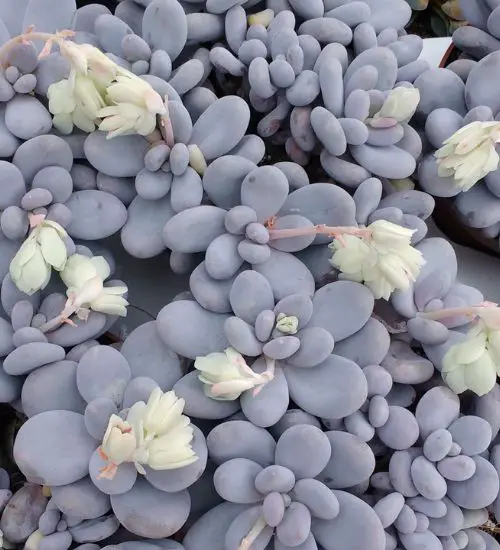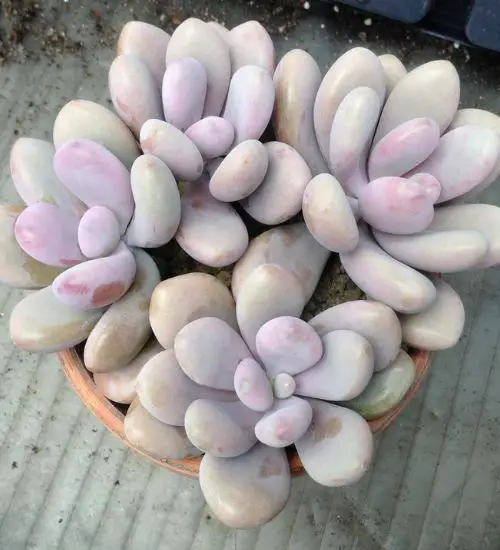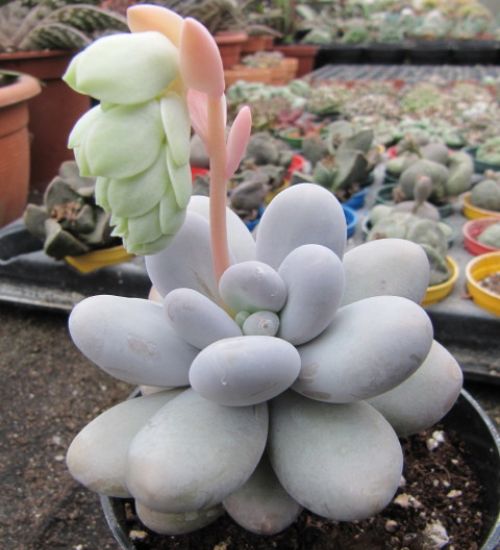Sun: full sun to partial shade
Water: Typical water needs for a succulent
Temperature: Zone 10a from 30° F to 35° F (-1.1 ° C to 1.7° C)
Winter Survival: Not cold hardy
Propagation: leaves, cuttings
Flower: In the Spring
Flower Type:
Toxic: Generally non-toxic to humans and animals
Dormant: summer
Space Requirement: Indoors
Common Problems: Plants may rot if overwatered, pests
Where to buy Pachyphytum oviferum?
Basc Care for Pachyphytum oviferum
Watering
What you need to remember is that this type of succulents needs to be watered for every 2 weeks
One simple tip for you is that you can use some online apps to check the soil status before you go water your succulents. I would recommend the ThePlantsCheck app, it has some nice features there.
Fertilizing
Only feed this succulent during its active growing seasons which means spring and fall. Use the right fertilizer applied in the right amounts. Applying half-strength balanced fertilizer every month or so is recommended for optimal results.
Do not fertilize during summer as the plant is dormant.
Sun & Location Requirements for "Pink Moonstone"
Pachyphytum oviferum needs full sun to partial shade in order to thrive. While this variety needs plenty of bright light, it is important not to place it in direct sunlight for extended periods of time as this can cause damage or scorching to the leaves and stems. A shadier spot with indirect light could be just what "Pink Moonstone" needs.
As per this succulent profile, it is only able to stay healthy when the environment temperature is above the range of zone 10a from 30° F to 35° F (-1.1 ° C to 1.7° C).
In order to ensure that Pachyphytum oviferum survives the winter, insulation and drainage are essential. A layer of mulch or gravel around the plant can help keep the roots warm during cold temperatures. Furthermore, avoiding exposure to wind and sun can reduce the risk of frost damage and promote longevity for your succulent.
Any succulents in the group will only need minimal space to grow. You can place your pot at your table or window. Outdoors is also a nice idea to put your pot.
Propagation
Propagating succulents by leaves is a great way to grow new plants from existing ones. Simply cut off a few healthy leaves from the mother plant and place them on top of a potting mix. Water the soil regularly, keeping it moist but not soggy, and soon you'll have brand new succulents!
One way to propagate Pachyphytum oviferum is by cutting
Toxicity

Pachyphytum oviferum is generally non-toxic to humans and animals. However, the plant may contain certain toxins which can cause mild skin irritation if it is ingested or comes in contact with skin. Therefore, it is important to keep the plant away from children and pets for safety reasons.
Pests and Diseases
Pachyphytum oviferum can be affected common pests and diseases like most of the other succulents such as mealybugs.
If you do spot any of pest signs, you can treat your succulent using below methods.
- Mealybugs: quarantine, clean infected plants, soapy water.
Besides that, to prevent serious health issues from happening, keep your succulent in a well-ventilated area and check it regularly for any signs of pests or health problems.


